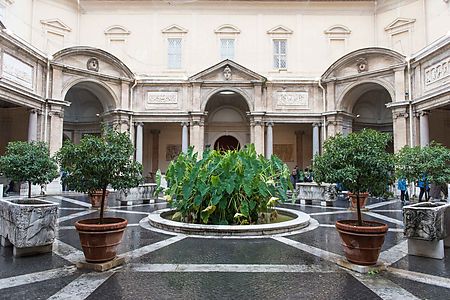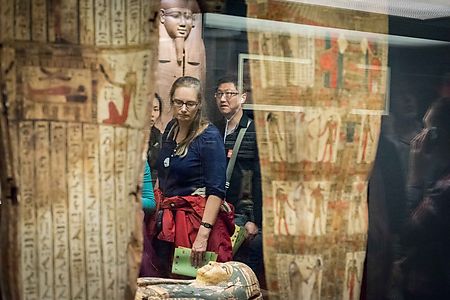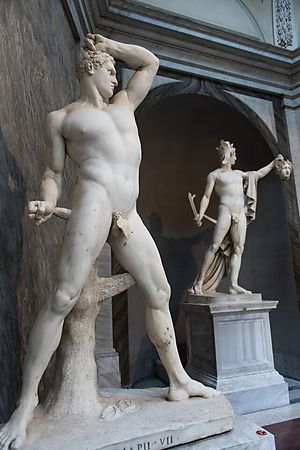Deaf Travel25th October 2015
Visually stimulating, the Vatican City is a must visit destination
Strolling around, going at your own pace, there is plenty of information on offer

One of my biggest joys in life is travelling. It takes some confidence to travel in different countries for anyone but there are additional barriers when you are deaf. However, there is so much to be gained from the experience of being in new places, meeting new people and doing things that take you far away from your day to day life, that the challenges are worth it.
I was delighted to join my stepmum for her 60th birthday holiday to Rome and Sorrento. She picked October which is a perfect time to travel in Southern Italy. It’s warm without being roasting hot and there are fewer tourists than at peak times in the summer holidays. Basically, the best possible conditions for sightseeing!


 The first day of sightseeing in Rome was spent visiting the Vatican City and trying to avoid the rain. The Vatican City is the World’s smallest independent state. It is ruled by the Pope and has it’s own economy. A UNESCO world heritage site, this walled city inside Rome consists of the Vatican Museums, Sistine Chapel and St Peter’s Basilica, plus other buildings and gardens.
The first day of sightseeing in Rome was spent visiting the Vatican City and trying to avoid the rain. The Vatican City is the World’s smallest independent state. It is ruled by the Pope and has it’s own economy. A UNESCO world heritage site, this walled city inside Rome consists of the Vatican Museums, Sistine Chapel and St Peter’s Basilica, plus other buildings and gardens.
 Top tip: For attractions such as St Peter’s Basilica and the Vatican Museums, book online for group entry with a tour company. This was useful for getting us into the Vatican quickly at our chosen time, avoiding the very long queues.
Top tip: For attractions such as St Peter’s Basilica and the Vatican Museums, book online for group entry with a tour company. This was useful for getting us into the Vatican quickly at our chosen time, avoiding the very long queues.
 We opted out of the guided tour. I was glad that we didn’t join the guided tours for two reasons; first, the groups are large and frustratingly obstructive meaning you can’t go at your own pace and spend time looking at the things that interest you and second, to hear the tour guide you needed to wear audio sets that use earbuds and it was so crowded it would be hard to position yourself well to lipread. Not much good for those with a hearing impairment. However, I much preferred to go through at my own pace, reading the exhibition information as I went along. If you happen to use Italian Sign Language, there are guided tours in ISL twice a week!
We opted out of the guided tour. I was glad that we didn’t join the guided tours for two reasons; first, the groups are large and frustratingly obstructive meaning you can’t go at your own pace and spend time looking at the things that interest you and second, to hear the tour guide you needed to wear audio sets that use earbuds and it was so crowded it would be hard to position yourself well to lipread. Not much good for those with a hearing impairment. However, I much preferred to go through at my own pace, reading the exhibition information as I went along. If you happen to use Italian Sign Language, there are guided tours in ISL twice a week!
 Top tip: Buy guide books and maps at each place you visit. They are packed with interesting information and images.
Top tip: Buy guide books and maps at each place you visit. They are packed with interesting information and images.
You don’t need to be religious to enjoy visiting the Vatican. There was far less religious art than I’d anticipated. During the early 16th Century Pope Julius II began accumulating the vast collections now held throughout the Vatican. Surprisingly, the Enlightenment movement inspired the desire to open up knowledge of art and culture to the public. Enlightenment signified a change in philosophy from a religious based view of the world to a more scientific one and the priceless artworks represent a significant journey through political, social and cultural changes in society across many centuries.

 Throughout my childhood I was fascinated by ancient civilisations and was really looking forward to seeing the Egyptian artefacts in the Vatican Museums. They didn’t disappoint. There are well preserved mummies and highly decorated coffins on display as well as ornaments, papyruses and jewellery from Ancient Egypt. The Egyptian Museum was established by Gregory XVI in 1839, in line with the Roman fascination with Egypt. Across Rome, where large obelisks dominate a number of Piazzas (squares), the continued interest in Egypt is apparent.
Throughout my childhood I was fascinated by ancient civilisations and was really looking forward to seeing the Egyptian artefacts in the Vatican Museums. They didn’t disappoint. There are well preserved mummies and highly decorated coffins on display as well as ornaments, papyruses and jewellery from Ancient Egypt. The Egyptian Museum was established by Gregory XVI in 1839, in line with the Roman fascination with Egypt. Across Rome, where large obelisks dominate a number of Piazzas (squares), the continued interest in Egypt is apparent.

 Heading on through the Vatican we took a really interesting journey through the cultural and artistic significance of Rome extending back over 2000 years. I must admit to having never been overly interested in the Romans beyond hoping to dig up a treasure chest of gold coins or armour in the garden. I found myself wishing that I had an extra day and no other tourists in my way so I could take it all in properly. It really was a fantastic way to gain an appreciation of history in a very visual way. Sculptures and paintings are an insight into people, fashions and society across the ages and really brings history to life. In a current context, it is a reminder of how culturally important that art is and that the loss of significant forms of our heritage is like losing a piece of our collective soul.
Heading on through the Vatican we took a really interesting journey through the cultural and artistic significance of Rome extending back over 2000 years. I must admit to having never been overly interested in the Romans beyond hoping to dig up a treasure chest of gold coins or armour in the garden. I found myself wishing that I had an extra day and no other tourists in my way so I could take it all in properly. It really was a fantastic way to gain an appreciation of history in a very visual way. Sculptures and paintings are an insight into people, fashions and society across the ages and really brings history to life. In a current context, it is a reminder of how culturally important that art is and that the loss of significant forms of our heritage is like losing a piece of our collective soul.
 The route through the Vatican culminates in the Sistine Chapel, home to the famous ceiling of Michelangelo paintings representing the nine scenes from the book of Genesis. The best known of these is ‘The Creation of Adam’. Michelangelo began work in 1508, finishing 4 years later. The skill and beauty of his work is tremendous. He spent years lying on his back on scaffolding with paint dripping into his eyes to create these vivid and beautiful frescos with technical perfection. As I stood directly underneath his work, which I’ve seen in images many times throughout my life, I felt that I was really seeing it for the first time. It was awesome in the true sense of the word.
The route through the Vatican culminates in the Sistine Chapel, home to the famous ceiling of Michelangelo paintings representing the nine scenes from the book of Genesis. The best known of these is ‘The Creation of Adam’. Michelangelo began work in 1508, finishing 4 years later. The skill and beauty of his work is tremendous. He spent years lying on his back on scaffolding with paint dripping into his eyes to create these vivid and beautiful frescos with technical perfection. As I stood directly underneath his work, which I’ve seen in images many times throughout my life, I felt that I was really seeing it for the first time. It was awesome in the true sense of the word.

Emerging from the Vatican at the bottom of the stunning spiral staircase, into a downpour, we bought a cheap umbrella from a street vendor and continued our exploration of the Vatican City. St Peter’s Basilica is a few minutes walk from the Vatican and is an equally huge and impressive building with another long queue to enter. We admired it from the huge square outside and carried on across the unevenly cobbled pavements towards the river. There are plenty of opportunities to buy souvenirs from stalls and shops along the streets. Take the time to just wander around and admire the beautiful architecture. Even in the pouring rain, Rome is dynamic and striking and makes for a really fulfilling day out.


Article by Natasha Hirst, Deaf Writer
posted in Deaf Lifestyle / Deaf Travel
25th October 2015





